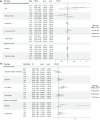This is a preprint.
Analysis of C-reactive protein omics-measures associates methylation risk score with sleep health and related health outcomes
- PMID: 39281736
- PMCID: PMC11398435
- DOI: 10.1101/2024.09.04.24313008
Analysis of C-reactive protein omics-measures associates methylation risk score with sleep health and related health outcomes
Update in
-
Methylation risk score of C-reactive protein associates sleep health with related health outcomes.Commun Biol. 2025 May 28;8(1):821. doi: 10.1038/s42003-025-08226-1. Commun Biol. 2025. PMID: 40437222 Free PMC article.
Abstract
Introduction: DNA methylation (DNAm) predictors of high sensitivity C-reactive protein (CRP) offer a stable and accurate means of assessing chronic inflammation, bypassing the CRP protein fluctuations secondary to acute illness. Poor sleep health is associated with elevated inflammation (including elevated blood CRP levels) which may explain associations of sleep insufficiency with metabolic, cardiovascular and neurological diseases. Our study aims to characterize the relationships among sleep health phenotypes and CRP markers -blood, genetic, and epigenetic indicators-within the Hispanic Community Health Study/Study of Latinos (HCHS/SOL).
Methods: In HCHS/SOL, methylation risk scores (MRS)-CRP and polygenetic risk score (PRS)-CRP were constructed separately as weighted sums of methylation beta values or allele counts, respectively, for each individual. Sleep health phenotypes were measured using self-reported questionnaires and objective measurements. Survey-weighted linear regression established the association between the multiple sleep phenotypes (obstructive sleep apnea (OSA), sleep duration, insomnia and excessive sleepiness symptom), cognitive assessments, diabetes and hypertension with CRP markers while adjusting for age, sex, BMI, study center, and the first five principal components of genetic ancestry in HCHS/SOL.
Results: We included 2221 HCHS/SOL participants (age range 37-76 yrs, 65.7% female) in the analysis. Both the MRS-CRP (95% confidence interval (CI): 0.32-0.42, p = 3.3 × 10-38) and the PRS-CRP (95% CI: 0.15-0.25, p = 1 × 10-14) were associated with blood CRP level. Moreover, MRS-CRP was associated with sleep health phenotypes (OSA, long sleep duration) and related conditions (diabetes and hypertension), while PRS-CRP markers were not associated with these traits. Circulating CRP level was associated with sleep duration and diabetes. Associations between OSA traits and metabolic comorbidities weakened after adjusting for MRS-CRP, most strongly for diabetes, and least for hypertension.
Conclusions: MRS-CRP is a promising estimate for systemic and chronic inflammation as reflected by circulating CRP levels, which either mediates or serves as a common cause of the association between sleep phenotypes and related comorbidities, especially in the presence of diabetes.
Figures



References
-
- Pataka A. & Riha R. L. The obstructive sleep apnoea/hypopnoea syndrome - An overview. Respir Med CME 2, 111–117 (2009).
-
- Colla-Machado P. E. et al. [Prevalence of silent cerebrovascular lesions in patients with obstructive sleep apnea syndrome]. Rev Neurol 62, 113–7 (2016). - PubMed
-
- Meier-Ewert H. K. et al. Effect of sleep loss on C-Reactive protein, an inflammatory marker of cardiovascular risk. J Am Coll Cardiol 43, 678–683 (2004). - PubMed
Publication types
Grants and funding
- UL1 RR033176/RR/NCRR NIH HHS/United States
- U54 HG003067/HG/NHGRI NIH HHS/United States
- N01 HC065236/HL/NHLBI NIH HHS/United States
- N01 HC065235/HL/NHLBI NIH HHS/United States
- U01 HL120393/HL/NHLBI NIH HHS/United States
- R01 HL071250/HL/NHLBI NIH HHS/United States
- N01 HC095167/HL/NHLBI NIH HHS/United States
- R01 HL161012/HL/NHLBI NIH HHS/United States
- R01 AG080598/AG/NIA NIH HHS/United States
- HHSN268201800001C/HL/NHLBI NIH HHS/United States
- UL1 TR001420/TR/NCATS NIH HHS/United States
- N01 HC095163/HL/NHLBI NIH HHS/United States
- R01 HL071205/HL/NHLBI NIH HHS/United States
- UL1 TR000040/TR/NCATS NIH HHS/United States
- N01 HC095166/HL/NHLBI NIH HHS/United States
- N01 HC095160/HL/NHLBI NIH HHS/United States
- HHSN268201300005C/HL/NHLBI NIH HHS/United States
- HHSN268201500003C/HL/NHLBI NIH HHS/United States
- HHSN268201300004C/HL/NHLBI NIH HHS/United States
- N01 HC095161/HL/NHLBI NIH HHS/United States
- N01 HC095168/HL/NHLBI NIH HHS/United States
- R01 HL071251/HL/NHLBI NIH HHS/United States
- R01 HL120393/HL/NHLBI NIH HHS/United States
- R01 HL071259/HL/NHLBI NIH HHS/United States
- HHSN268201300003I/HL/NHLBI NIH HHS/United States
- R01 AG048642/AG/NIA NIH HHS/United States
- RF1 AG061022/AG/NIA NIH HHS/United States
- UL1 TR001079/TR/NCATS NIH HHS/United States
- N01 HC095169/HL/NHLBI NIH HHS/United States
- N01 HC065233/HL/NHLBI NIH HHS/United States
- R56 AG048642/AG/NIA NIH HHS/United States
- HHSN268201300001C/HB/NHLBI NIH HHS/United States
- N01 HC095159/HL/NHLBI NIH HHS/United States
- N01 HC065234/HL/NHLBI NIH HHS/United States
- P30 DK063491/DK/NIDDK NIH HHS/United States
- R01 HL071051/HL/NHLBI NIH HHS/United States
- HHSN268201300003C/HG/NHGRI NIH HHS/United States
- R01 AG075758/AG/NIA NIH HHS/United States
- HHSN268201500014C/HL/NHLBI NIH HHS/United States
- HHSN268201500003I/HL/NHLBI NIH HHS/United States
- R01 HL117626/HL/NHLBI NIH HHS/United States
- N01 HC095162/HL/NHLBI NIH HHS/United States
- UL1 TR001881/TR/NCATS NIH HHS/United States
- N01 HC095165/HL/NHLBI NIH HHS/United States
- N01 HC095164/HL/NHLBI NIH HHS/United States
- N01 HC065237/HL/NHLBI NIH HHS/United States
- K99 HL166700/HL/NHLBI NIH HHS/United States
- R01 HL071258/HL/NHLBI NIH HHS/United States
LinkOut - more resources
Full Text Sources
Research Materials
Miscellaneous
